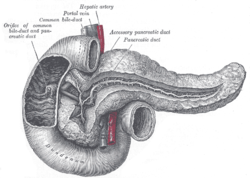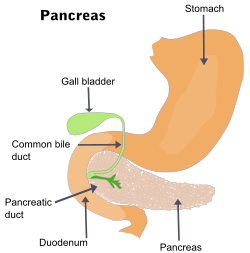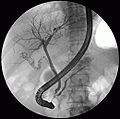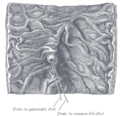- Pancreatic duct
-
"Pancreatic duct of Wirsung" redirects here. For the pancreatic duct of Santorini, also known as the accessory pancreatic duct, see Accessory pancreatic duct.
Pancreatic duct 
The pancreatic duct. 
Latin ductus pancreaticus Gray's subject #251 1202 Precursor Pancreatic bud MeSH Pancreatic+Ducts  1. Bile ducts: 2. Intrahepatic bile ducts, 3. Left and right hepatic ducts, 4. Common hepatic duct, 5. Cystic duct, 6. Common bile duct, 7. Ampulla of Vater, 8. Major duodenal papilla
1. Bile ducts: 2. Intrahepatic bile ducts, 3. Left and right hepatic ducts, 4. Common hepatic duct, 5. Cystic duct, 6. Common bile duct, 7. Ampulla of Vater, 8. Major duodenal papilla
9. Gallbladder, 10-11. Right and left lobes of liver. 12. Spleen.
13. Esophagus. 14. Stomach. Small intestine: 15. Duodenum, 16. Jejunum
17. Pancreas: 18: Accessory pancreatic duct, 19: Pancreatic duct.
20-21: Right and left kidneys (silhouette).
The anterior border of the liver is lifted upwards (brown arrow). Gallbladder with Longitudinal section, pancreas and duodenum with frontal one. Intrahepatic ducts and stomach in transparency.The pancreatic duct, or duct of Wirsung (also, the Major pancreatic duct due to the existence of an accessory pancreatic duct), is a duct joining the pancreas to the common bile duct to supply pancreatic juices which aid in digestion provided by the "exocrine pancreas". The pancreatic duct joins the common bile duct just prior to the ampulla of Vater, after which both ducts perforate the medial side of the second portion of the duodenum at the major duodenal papilla.
The duct of Wirsung is named after its discoverer, the German anatomist Johann Georg Wirsung (1589–1643).[1]
Contents
Accessory pancreatic duct
Most people have just one pancreatic duct. However, some have an additional accessory pancreatic duct, called the Duct of Santorini.
Clinical significance
Compression, obstruction or inflammation of the pancreatic duct may lead to acute pancreatitis. The most common cause for obstruction is choledocholithiasis, or gallstones in the common bile duct. Obstruction can also be due to Duodenal Inflammation in Crohn's Disease [1]. A gallstone may get lodged in the constricted distal end of the ampulla of Vater, where it blocks the flow of both bile and pancreatic juice into the duodenum. Bile backing up into the pancreatic duct may initiate pancreatitis.[2]
Pancreatic ductal carcinoma is a common form of pancreatic cancer.
Additional images
References
- ^ doctor/2941 at Who Named It?
- ^ Moore, Keith L.; Dalley, Arthur F. (2006). Clinically Oriented Anatomy, Fifth Edition. Lippincott Williams & Wilkins. p. 287. ISBN 0-7817-3639-0.
Categories:- Pancreas anatomy
- Digestive system stubs
Wikimedia Foundation. 2010.





